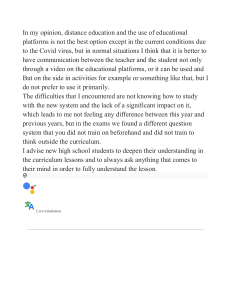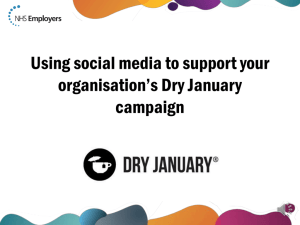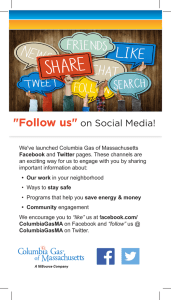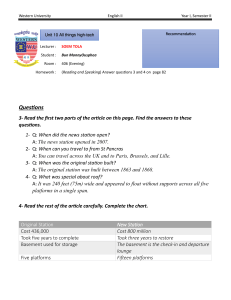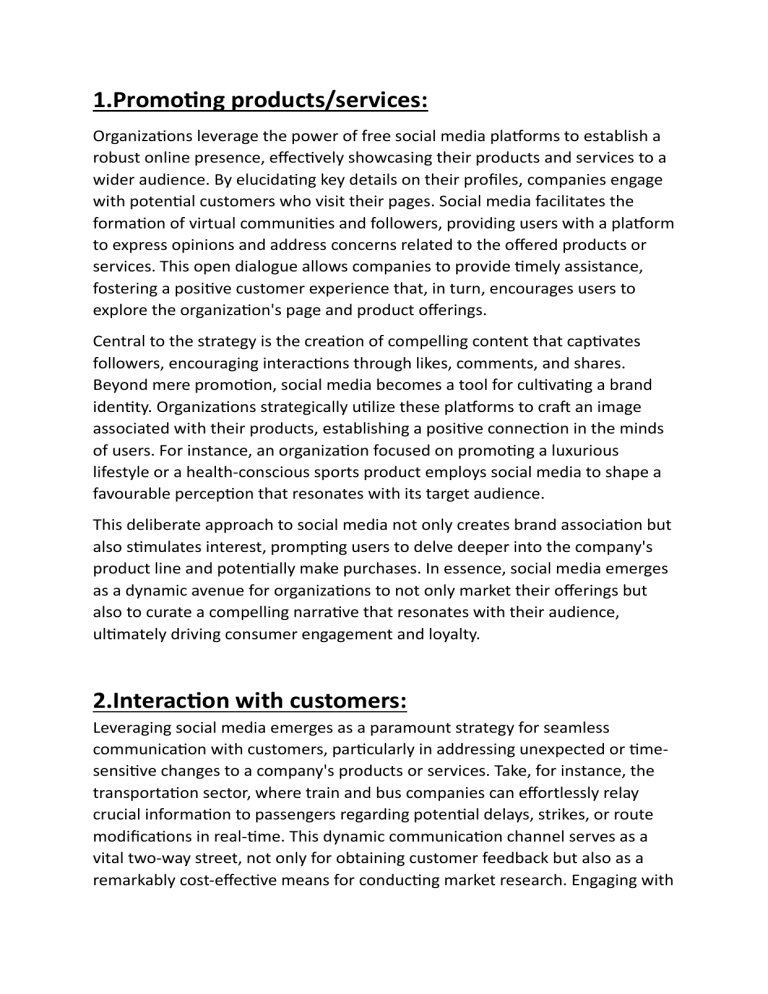
1.Promoting products/services: Organizations leverage the power of free social media platforms to establish a robust online presence, effectively showcasing their products and services to a wider audience. By elucidating key details on their profiles, companies engage with potential customers who visit their pages. Social media facilitates the formation of virtual communities and followers, providing users with a platform to express opinions and address concerns related to the offered products or services. This open dialogue allows companies to provide timely assistance, fostering a positive customer experience that, in turn, encourages users to explore the organization's page and product offerings. Central to the strategy is the creation of compelling content that captivates followers, encouraging interactions through likes, comments, and shares. Beyond mere promotion, social media becomes a tool for cultivating a brand identity. Organizations strategically utilize these platforms to craft an image associated with their products, establishing a positive connection in the minds of users. For instance, an organization focused on promoting a luxurious lifestyle or a health-conscious sports product employs social media to shape a favourable perception that resonates with its target audience. This deliberate approach to social media not only creates brand association but also stimulates interest, prompting users to delve deeper into the company's product line and potentially make purchases. In essence, social media emerges as a dynamic avenue for organizations to not only market their offerings but also to curate a compelling narrative that resonates with their audience, ultimately driving consumer engagement and loyalty. 2.Interaction with customers: Leveraging social media emerges as a paramount strategy for seamless communication with customers, particularly in addressing unexpected or timesensitive changes to a company's products or services. Take, for instance, the transportation sector, where train and bus companies can effortlessly relay crucial information to passengers regarding potential delays, strikes, or route modifications in real-time. This dynamic communication channel serves as a vital two-way street, not only for obtaining customer feedback but also as a remarkably cost-effective means for conducting market research. Engaging with customers through social media provides a swift and straightforward avenue for soliciting opinions on areas where the company can enhance its offerings, fostering a sense of value for users and cultivating a positive company image that resonates continuously. Social media's efficacy extends beyond mere communication to the realm of customer service, offering a rapid and efficient avenue for query resolution. The accessibility and familiarity users have with social media platforms contribute to the success of this approach. Customers can effortlessly submit their issues and questions, receiving prompt responses. Platforms such as Twitter enable users to tweet the company directly, while online communities on Facebook and Reddit facilitate comprehensive discussions. However, to ensure the utmost effectiveness, companies must dedicate resources to regularly monitor and engage with these online communities. This proactive approach prevents customers from feeling overlooked or neglected, reinforcing a commitment to customer care and enhancing overall satisfaction. 3.Attract users to company: Social media platforms operate on a user-friendly model, allowing individuals to create accounts without incurring charges. The financial backbone of these platforms lies in offering companies paid advertising opportunities. Take Facebook, for instance, where advertisements seamlessly integrate into the right sidebar of the main news feed on the full desktop version. Similarly, Twitter employs "promoted tweets," a paid feature that surfaces among the tweets from users you follow on your Twitter page. Notably, social media platforms enable advertisers to target specific demographics, considering factors such as age, gender, and recent search history. This customization attracts organizational users, prompting platforms to provide tailored features to meet their needs. For businesses, social media offers a robust framework for creating dedicated pages and profiles. These serve as informative hubs, detailing the organization's activities, business objectives, and geographical location. Some platforms go the extra mile by providing tools that furnish detailed demographic profiles of the visitors to an organization's pages, shedding light on user interactions. Facebook Insights, a prime example, stands out as a powerful tool for gauging post effectiveness and understanding the social media audience. Twitter™ and Google™ also contribute their own analytics tools to the mix. When it comes to advertising on platforms like Facebook, strategic targeting is key. For instance, a local plumber might tailor ads to reach individuals in the immediate vicinity. On e-commerce giants like Amazon, recent searches influence product recommendations prominently featured on the home screen. Recognizing the increasing mobile usage trend, social media platforms have optimized their interfaces to seamlessly fit various screens, particularly those of touch-enabled devices with lower processing power. This adaptability ensures users can stay connected on the go. In the realm of digital marketing, social media plays a pivotal role in search engine optimization (SEO). Employing specific techniques can enhance a website's ranking, with the underlying theory being that businesses appearing at the top of search results are more likely to attract customer attention and inquiries. As social media continues to evolve, its multifaceted impact on online presence, advertising, and SEO underscores its indispensable role in the contemporary digital landscape. 4.ways which a business can use social media: The ubiquity of social media, with over 1 billion active users on platforms like Facebook alone, presents organizations with an unparalleled opportunity to tap into an expansive market for their products and services. While any organization can establish a presence across various social media platforms, merely creating a profile is insufficient. The key lies in actively cultivating a following and engaging with potential customers. In essence, social media profiles must not remain dormant; they require consistent updates with compelling posts that invite and stimulate customer interaction. Diverse content can be shared on social media platforms, encompassing text, images, and, on platforms like Facebook and YouTube, videos. Facebook proves effective for concise promotional videos, while YouTube serves as an optimal choice for instructional content, as videos are static in their YouTube channel, ensuring lasting accessibility. The synergy between different social media platforms is evident in their ability to complement one another. For instance, if an organization provides customer service through Facebook and Twitter™ and a customer inquiry arises, a response could include a link to a relevant instructional video on the organization's YouTube channel. Most social media platforms facilitate the inclusion of web page links in posts, providing organizations with the means to seamlessly connect their social media presence with their official website. For instance, organizations utilizing Twitter™ often pair a brief comment (given the 140-character limit) with a link to a webpage or a blog article. Additionally, specialized features such as the Facebook Poll app enable the incorporation of polls into posts. This functionality proves invaluable for collecting customer feedback on new products or versions. Furthermore, the Facebook Quiz app adds an interactive dimension, allowing organizations to create knowledge quizzes or engaging 'personality quizzes.' As an example, a jeweller might craft a 'What kind of jewellery suits your personality?' quiz, tailoring product suggestions based on users' quiz responses. In essence, the dynamic landscape of social media offers organizations a multifaceted toolkit to not only disseminate information but also to foster engagement, enhance customer relationships, and creatively market their products or services. 5.Audience profiles: A foundational concept in comprehending how organizations leverage social media revolves around the notion of the 'audience profile.' Essentially, the audience profile of a social media platform encapsulates the characteristics of its registered users, encompassing factors like age group, gender, geographical location, and more. Notably, these profiles differ across various social media websites and evolve over time. For instance, research in 2015 revealed a gender disparity on Twitter™, with more male users, while Instagram exhibited a higher concentration of female users, alongside a generally younger audience. Pinterest stood out for its predominantly female user base compared to other mainstream platforms. The dynamic nature of social media usage is exemplified by shifts observed among teenagers in the US. In 2015, Twitter™ experienced a decline in teenage users, while Instagram and Snapchat™ witnessed a rise. Nevertheless, Twitter™ retained its status as the second most important social media network for US teenagers. In contrast, LinkedIn®, with its emphasis on professional connections, resonated more with the over 50 age group than other popular platforms. An invaluable advantage for organizations utilizing social media is the ability to discern and understand the audience profile they attract. Platforms like Facebook and Twitter™ furnish tools that offer demographic insights into the followers of a page. These analytic tools, exemplified by Facebook Insights, not only reveal the demographic makeup of the audience but also gauge the effectiveness of individual posts. Beyond understanding their audience, organizations harness social media for a myriad of purposes: To be informative: Describing an organization's history, aims, and objectives to cultivate an image or brand. It also serves as a rapid conduit for disseminating crucial information, such as changes to train schedules. To promote: Actively advertising and endorsing products, services, and the overall ethos of an organization. To entertain: Depending on the nature of the organization, posting humorous or engaging content can resonate with potential customers. To make offers: Social media becomes a platform for organizations to extend special offers, whether it's providing time-limited discounts for page engagement or offering prizes to milestone likers. To provide customer service: Responsiveness to customer posts on social media enhances the perception of organizational efficiency and effectiveness, showcasing a commitment to addressing customer concerns promptly. In essence, social media serves as a versatile canvas for organizations to paint a comprehensive picture of their identity, engage with their audience, and fulfil various business objectives, from promotion and entertainment to customer service and beyond.
